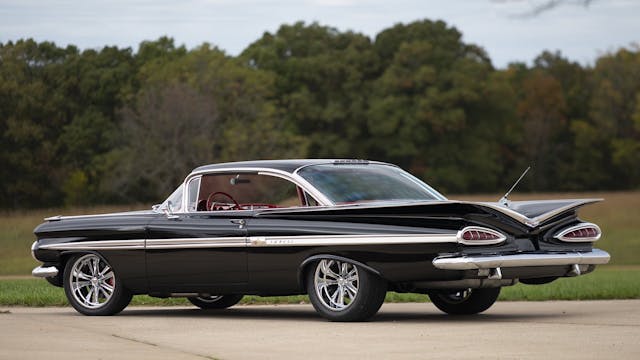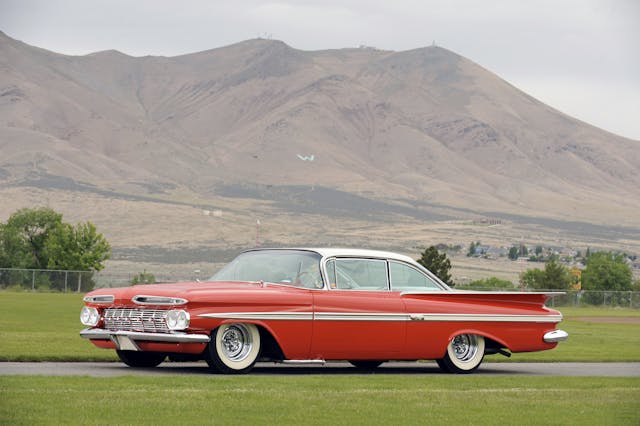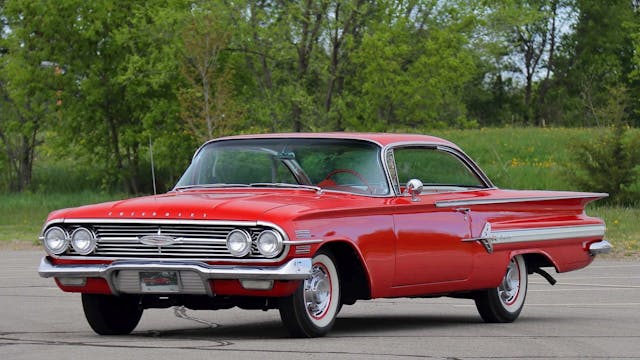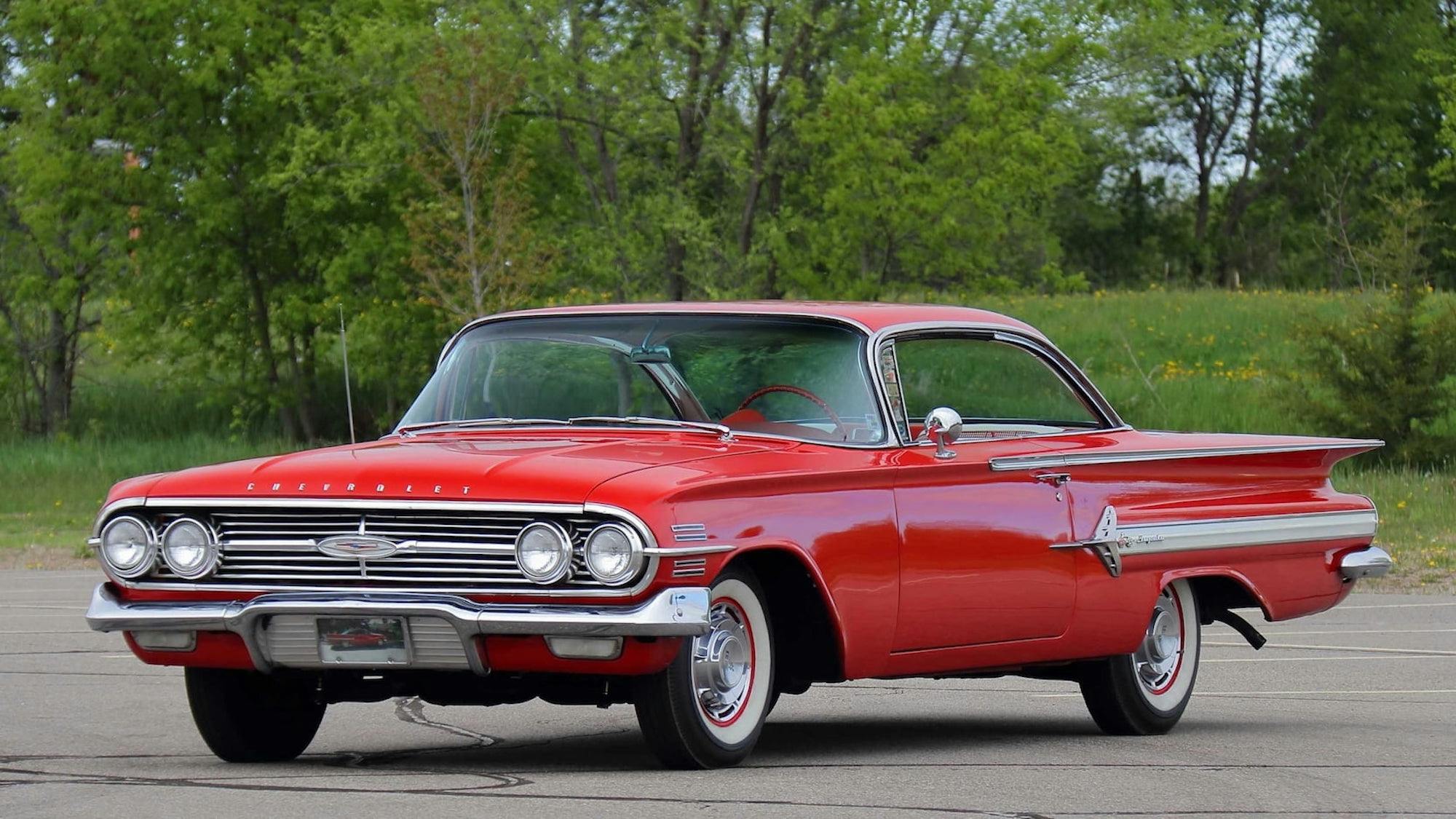Media | Articles
Ever adaptable to changing tastes, the ’59–60 Impala will never fade
There are few classic cars as versatile as the venerable Chevrolet Impala. Sure, it’s generally been an enormous land yacht designed to comfortably carry an American family, but the model quickly found love in drag racing as well as in the custom and lowrider scenes. Its reputation for attainable full-size performance extends over decades of production.
Although you’ll find Impalas of all eras in collectors’ garages, the second-generation (1959–1960) cars are particularly noteworthy for the way they transcend their era and their genre.
While considerably different from their Tri-Five predecessors, the first-gen (1958) Impalas still had one foot in the ’50s from a design perspective. General Motors made big styling changes for 1959, dramatically redesigning models across the board. The Impala, which had been a Bel Air trim in ’58, was now its own model and grew longer, lower, wider, and heavier. The Impala also sported GM’s wide-open greenhouse theme, which featured acres of glass framed by delicate pillars.

While each has its own character, the 1959 and 1960 Chevrolet Impalas have a lot in common. The two years feature the boldest fins to ever grace a Bowtie. Wider than they are tall, the fins are actually restrained relative to many of the flamboyant variations offered by other brands during the late ’50s and early ’60s. The Impala’s still managed to make a statement, though. 1959 models feature gracefully curved fins and prominent, cat-eye taillights, while the 1960 model foreshadows what was to come with more angular, trim fins and simple, round taillights that would become a Chevrolet trademark through 1965.
For performance, second-gen Impala buyers had the option of inline-six, 283-cubic-inch small-block V-8, or 348-cu-in big-block. A 250-hp version of the 348 came with a single four-barrel carburetor, while a triple-carbed version was available that packed 280 hp.
Marketplace
Buy and sell classics with confidence
Racing-minded Chevy buyers had more options still. They could opt for a 305-hp, four-barrel 348-cu-in V-8, which featured a solid-lifter valvetrain and higher compression ratio, or they could go whole-hog and slap three two-barrel carbs on for a then-potent 335 horses.
Chevrolet would wring even more performance out of the third-gen cars, strengthening the 348 engine in 1961 and introducing the fabled 409 as well, giving the bubble-top Impala that followed even more power. Still, ’59 and ’60 Impalas resonate with collectors because they established the nameplate’s performance pedigree and introduced the long, low look for which the model came to be known.

Impalas roam a large swath of geography, although predictably, most are found in sunnier climates. Western and Southern states lay claim to 57 percent of Hagerty-insured Impalas.
You’d think the audience would skew older for a car that debuted when many baby boomers were, well, babies; yet Gen-Xers and younger enthusiasts made up a full 54 percent of people calling Hagerty for quotes on insurance for these cars in 2022. That’s a ten percent increase since 2019.
These cars have long been a popular canvas for customization, and it appears that the appetite for modifying these cars is only increasing: In 2018, only 13 percent of Impalas sold at auction had been altered, but by 2022 that number had risen to 32 percent. During that same time, the value for a modified ’59–60 Impala increased 43 percent, from $92,000 to $132,000. Note this follows a trend we’ve seen for other 1950s classics, namely the C1 Corvette. Younger collectors in particular may be less concerned with originality for these cars and more interested in updates that make them drive more like modern cars.
The widespread interest in these Impalas has helped sustain values—and then some. Per the latest Hagerty Price Guide, condition #2 (Excellent) Impalas have appreciated an average of 27 percent since 2018, to $49,800. Naturally, the coupes and convertibles have seen bigger bumps. A sport coupe with the big engine and the triple-two-barrel setup can run into the six figures. Happily, there are still great buys out there as well: A four-door sedan with a 283 V-8 in average (#3) condition can be yours for less than $15,000. It should be easy to maintain mechanically—we are talking about body-on-frame, rear-drive, and a small-block Chevy, after all—but body work can get costly, simply because there’s so much sheetmetal.
These early Impalas wound up being overshadowed to some degree by the infamous 409 cars that followed (that’s what The Beach Boys will do for you). Yet as they near 65 years old, they maintain their popularity on the classic car scene because they’re so adaptable. Sunday cruiser, modded drag-strip monster, flamboyant lowrider—the ’59–60 Impala is game.

Check out the Hagerty Media homepage so you don’t miss a single story, or better yet, bookmark it.





Ours always honked when we made a left hand turn LOL
Still have a 60 red Impala just like the picture. Has 3 on the tree with overdrive. 283 with a 4 barrel Holley but has a spot light on drivers side door panel.
To me this is arguably the Impala’s best “classic” look.
I have a 1959 Chevy impala 4 door sedan. It has a 235 6 cyl 1 barrel carb with no oil filter ( that was an 8 dollar option which the Omer thought was too much money. It does have an oil bath air filter witch the Owner paid 5 dollars for. I love this car so much style and room. Will run down the highway 80 miles an hour all day long with 5 200+ pound people. Drove to ocean city cruise in 4 years now (600+ miles round trip) and gets 20 miles to the gallon.
At Barrett Jackson in March 2021 there was a 789 Chevy The front was a 57, the middle a 58 and the rear a 59.
It was a show stopper and done exceptionally well. Best of many worlds of design. I wonder what was inder the hood, surely a 348.
All of them back then had some style of sorts unlike the dozen egg`s we all drive today.
Sure would be nice to see some style built into some of these that are built today.
My dad bought his first new car, it was a 1960 Impala. He worked for the airlines and our family vacation that year was to fly out to Detroit and purchase this new car. He took his 8mm camera to record the car coming out of the factory. Gleaming red with a white top two door hardtop. Hub caps, not full wheel covers, 283 V-8 with a three on the tree. Manuel brakes and steering and no radio. So we piled in and headed back home to Portland. Somewhere in the Black Hills on a hot summer day we were parked on the side of the road for what seemed like hours as my dad climbed down a steep embankment to try and retrieve a lost hub cap. He never found it so we moved on. Later that day were were clipped by a large truck in a tunnel that did some minor damage to the drivers side tail fin (wing). The next day we came back into the car after eating at a diner to find the bag of crayons we left in the hot sun had melted and left a blue stain in the back seat. Dad drove that car until it had too many issues and traded it in in 1968.
I always loved the look of that car and I bought one in 1977. Paid $600 for a white two door Impala. Body and dash were perfect. Interior needed work and the motor was tired. I thought of dropping in a V-8 but ended up rebuilding the Blue Flame 235 and put in split dual exhaust. That car would cruise smooth at 100+ mph and I swear it was those wings that stabilized it. Wish I had kept that car when I see how much they are selling for now. Great article!!
My father was a GM mechanic in the 1950s. And he claimed that GM had issues on the early 59’s due to poor paint coverage on the underside of the wings due to depth of the wings and early models repaired at the dealership. Does anyone have any further information on this?
MY FIRST ENCOUNTER WITH A ’59 CHEVY WAS MY AUNT’S BISCAYNE. I WAS VISITING AT HER LODGE (TODAY THEY CALL ‘EM B&B) SHE HAD A SOFT REAR TIRE AND I TOLD HER I COULD CHANGE THAT FOR HER. WELL, AFTER I GOT THAT 2nd BUMPER JACK FULLY EXTENDED I COULDN’T GET THAT CAR BACK DOWN TO EARTH. THE COIL SPRINGS WERE SO WEAK THE REAR END JUST FLOPPED THERE IN MID AIR. AS LUCK WOULD HAVE IT A NICE 20 SOMETHING GUY CAME BY AND HELPED ME GET OUT OF THAT PICKLE. HE TOLD ME LATER THAT HE HAD SEEN THOSE TWO JACKS AND KNEW SOMETHING WAS WRONG. MY NEIGHBOR ACROSS THE STREET HAD A ’60 IMPALA CONV. WHITE/BLUE TOP, SIDE SPEAR, AND BLUE & WHITE HOUNDS TOOTH INTERIOR. 348 POWER GLIDE. BEST OF ALL HE HAD FOUR GIRLS, 2 IN H.S. 1 JR. HIGH, AND THE YOUNGEST IN MY GRADE. WE HAD SO MUCH FUN KRUZIN THE LOCAL DRIVE IN’S. THE OLDER GIRLS WOULD ALWAYS ASK TO USE THE CAR AND WITH A BACK SEAT FULL OF PUNKS GOOD OLD DAD FIGURED NO PROBLEM. THE OLDER CHICKS LIKED TO HAVE ME ALONG BECAUSE I ALWAYS HAD MONEY TO BUY LIL’ SIS AND ME THOSE 15 CENT COKES AT MC DONALD’S. THOSE WERE THE GOOD OLD DAYS!!!
My Dad was an accountant. I was raised with Nash Ramblers and Ambassadors. In fact, we had a 1959 Rambler on order when the Chevys were unveiled. My Father saw the photo of the new Chevy in the newspaper, and decided we had to have one–quite uncharacteristic of him. He was a numbers guy, not prone to that sort of an emotional outbreak.
We visited the dealer on opening day–a big deal back then. Unfortunately, GM was on strike, so the dealers had very little in the way of stock. Dad made an offer on the showroom car, and agreed that it would stay in the showroom until the dealer could replace it. The car was like the black one in the C/D article–an Impala coupe; gunmetal gray, with white top surfaces (roof and trunk), and red interior. It had the 348, with a Turboglide transmission, plus a power ash tray. Nobody in the family smoked. We had never had a car with anything bigger than a Nash flat-head six. It was stunning.
I was 14 at the time, so that was the car we had when I learned to drive. The Turboglide was essentially a CVT transmission, able to “kick down” from a standing start. The car had relatively little weight over the rear wheels, so it was easy to get in trouble with it. I was responsible for keeping it washed and waxed, so I knew every curve on that body.
The bad news is that after three years of Maryland winters, you could see rust coming from places where chrome met paint. The dual exhaust system had let go. There were several problem with the engine misfiring. It was not a great example of reliable transportation.
Even in a sea of other cars with “fins” it was beautiful enough to elicit an emotional response–one that I still get on the very rare occasion I see one. The 1960 version seemed a less “pure” version of whatever inspired the original design.
While I’ve always found myself attracted to small cars, that 59 Chevy is what sparked my interest in cars that are more than just transportation. It effected Dad, too. Eventually, he traded it for a Pontiac Bonneville. Later in life he had an Olds 442 convertible.
Something I’ve learned in life is that beautiful design–something reaching for an ideal in the designer’s head–trancends size, sophistication, and age. These cars are not always the most reliable ones, or the most practical. They are the ones you can’t walk away from without turning for one last look.
The ’59 Chevy coupe was one of those.
Was at a car show at Lacy Park, San Marino, California some months back. There was a magnificent black ’59 Impala convertible with the original equipment fuel injection and all the proper intake ducting.
My first 59 was a black 348 3×2 turboglide convertible. I was 17. I didn’t really like it. as it was cranky, thirsty and hot. The car wasn’t reliable but I attest some of this to being young and dumb. I sold that car in the early 80s and bought a red and black two tone convertible from the original owner only this one was a 283 with a powerglide. The car also had power steering, brakes, windows, seat along with ac, padded dash, signal seek radio and the headlight dimmer. What a great car. That car went everywhere. Unfortunately it had the one malady that plagued many, floor and rocker rust. Thinking I was doing the right thing I took it to a so-called restoration shop. I went west and shipped a complete rustfree floor assembly for them and thought that was that. The car drove in but never saw the road again. Once I got what was left back, I realized it was finished. I bought a 60 convertible with hopes of saving it but gave up and moved to a 60 Caddy convertible. I kept the car to remind me never to take a vehicle to a shop ever again and have not for over 30 years. It and the 60 that was supposed to save it lie instate rusting slowly back into the earth. I like my 60 Caddy but it will never fill the shoes of the 59 Chevy. Being in the later years now at some point in the near future I will say my goodbyes and send it to the shred. I learned quite a bit from that but I wish it had been one of my other cars that I kept throughout my lifetime.
I find it very hard to find a 59 or 60 Impala in 1/24 or 1/5 models. I thought is the rear wings are hard to plastic molds.